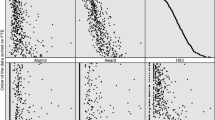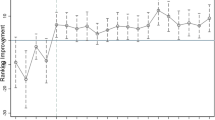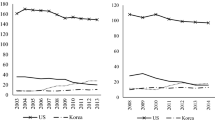Abstract
In this article I introduce a new indicator that measures the presence of a higher education system in the Shanghai Jiao Tong Academic Ranking of World Universities (ARWU). First, the benefits of introducing such a measure and the drawbacks associated with the possible choices of the indicator are discussed. To analyze the drawbacks, the sample of countries with presence in ARWU is split into two groups of small and large world’s GDP share. A raw indicator based upon the sum of the scores of all the universities from a country divided by its world’s GDP share shows a noticeable bias in favor of small countries, so a one-way between-groups analysis of variance is conducted to help in canceling the bias. That leads to the introduction of a new aggregate indicator that can be computed in a very simple fashion. A discussion of the performance of higher education systems using this new indicator closes the paper.

Similar content being viewed by others

References
Cohen, J. (1988). Statistical power analysis for the behavioral sciences (2nd edition). Lawrence Erlbaum Associates, Inc., Hillsdale, NJ.
Dehon, C., McCathie, A., & Verardi, V. (2010). Uncovering excellence in academic rankings: A closer look at the Shanghai ranking. Scientometrics, 83(2), 515–524.
Docampo, D. (2008). International rankings and quality of the university systems. Revista de Educación, Special Issue, 149–176.
Docampo, D. (2011). On using the Shanghai ranking to assess the research performance of university systems. Scientometrics, 86(1), 77–92.
IMF. (2009). World Economic Outlook Database: October 2009 Edition. Downloaded from the International Monetary Fund server on November 19th 2009. http://www.imf.org/external/pubs/ft/weo/2009/02/index.htm.
IMF. (2010). World Economic Outlook Database: October 2010 Edition. Downloaded from the International Monetary Fund server on June 7th 2011. http://www.imf.org/external/pubs/ft/weo/2010/02/weodata/index.aspx.
Liu, N. C., & Cheng, Y. (2005). Academic ranking of world universities: Methodologies and problems. Higher Education in Europe, 30(2), 127–136.
Author information
Authors and Affiliations
Corresponding author
Rights and permissions
About this article
Cite this article
Docampo, D. Adjusted sum of institutional scores as an indicator of the presence of university systems in the ARWU ranking. Scientometrics 90, 701–713 (2012). https://doi.org/10.1007/s11192-011-0490-y
Received:
Published:
Issue Date:
DOI: https://doi.org/10.1007/s11192-011-0490-y



